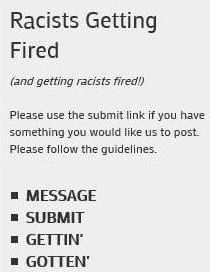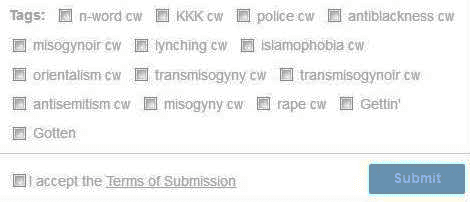

The accessibility of the internet allows nearly anyone to say nearly anything, regardless of its wisdom. On the web, power seems to be in the hands of the people posting content. Emerging from this chaos of expression and speech is a digital system of checks-and-balances, in which those speaking so freely online can be called out for their negative utterances by any other denizen of the online world. This criticism of what is said online can easily travel into the lives and jobs of offline persons. Take the Tumblr account Racists Getting Fired as an example. The page is “dedicated to publicly revealing the identities of people who use social media to express racist viewpoints, and then contacting their employers” (Haggerty, 2014). The blog originated in response to the heated reactions and racially-charged postings that followed the shooting of Michael Brown in Ferguson, Missouri. Eventually, the website’s wider potential in sharing and shaming racists became apparent; One such posting screen captured and listed on the site was a tweet by an individual who said of Baltimore rioters (after a controversial death in police custody), “I’m sure all those pieces of shit went right to the pharmacy and stole every drug in that CVS.” Another site visitor comments: “So this woman think she can not lose her job. It’s crazy in Baltimore right now and She saying racists things. Please call her job […]. Please REBLOG! We came together before, let’s put a end to ignorance! I will be calling the corporate office Monday morning!” Another signaled their support with the succinct command to those listening to “DESTROY HER INCOME.” When University of Oklahoma fraternity members were caught on video singing a racist song, their names and family information were quickly posted on the site, along with comments such as “The expelled OU racists’ names are […]. Spread their names. Make them exist in infamy. Make sure they can never get jobs beyond (maybe) working for their parents.” Successful campaigns are listed in the section labeled “gotten,” dedicated to the success stories of the racists who had been fired from their jobs after being featured on this site. Many of these “vigilantes” are proud of the blog’s victories, as it “provides a gleeful jolt of dopamine when there are actual results” (McDonald, 2014).

While it does not completely disable structural racism in our society, defenders point to the blog as providing a method of delivering justifiable consequences to outed individual racists. Speech has consequences, such defenders say, and the Racists Getting Fired blog is merely coordinating individual efforts to point out such hateful utterances to the alleged racists’ employers and schools. People are free to be racists online, but they should not expect to be free of the criticism and the negative publicity that this expressivity might bring with it.
But critics worry that crowd-sourced vengeance for societal wrongs might go too far. One concern is that by going beyond mere criticism to the organized contacting of a alleged racist’s employer or educational institution, the anti-racist activists transgress the limits of ethical speech. Accountability of such campaigns is compromised, and there are often few checks of the quality of claims that allege that an individual is actually a racist. Take the example of Brianna Rivera. Rivera’s vengeful ex-boyfriend created a fake profile posing as Rivera, posted a number of racist remarks, and then sent screenshots of the faux posts to the Racists Getting Fired Tumblr blog (Levine, 2014). It didn’t take long for the blog’s community to begin their attacks on her and her employer. Thanks to observant users, the post was revealed to be fake and the blog ceased to share it, although versions of the original post remained on Tumblr. Rivera was able to keep her job, though she could never reclaim her reputation as her name would always be associated with the original Tumblr post. This case shows that even with screenshot “evidence,” innocent people could be harmed. Furthermore, even if an individual actually made a racist post or comment, one might still object that being a racist shouldn’t automatically result in being fired or losing one’s economic livelihood. After all, there are many professions were workers can do their jobs adequately while subscribing to incorrect—or even hateful—views.
Motivating supporters of Racists Getting Fired is the sense that they are creating social sanctions and economic harms for those who deserve such a punishment for holding racist views; this seems to be part of a strategy that will de-incentivize the holding of racist views in our communities. Meredith Haggerty doubts this tactic will work, and argues that these blogs aren’t going to truly change anything in society: “while watching [a racist] apologize for his comments is cathartic, and honestly, hilarious, it seems naive and unreasonable to think that there is now less hate in his heart” (Haggerty, 2014). She declares that public outings like this are “dangerous impulses.” Asam Ahmad argues for the practice of “calling in” instead of “calling out” or shaming those who make racist remarks: “calling in means speaking privately with an individual who has done some wrong, in order to address the behaviour without making a spectacle of the address itself.” Ahmad advocates this manner of reacting to racists as it seems to holds the best chance for fixing racist attitudes—public shaming simply harms racists, and makes them all the more defensive against the activists causing this harm.
As activism grows in dispersed but unified online publics, the question becomes all the more imperative: Do these crowd-sourced sites and tactics assist in the battle against hate and social injustice, or do they simply represent a new means of abuse and create further animosity among fellow citizens?
Discussion Questions:
- What ethical values are in conflict with sites such as Racists Getting Fired?
- Do you agree with the “naming and shaming” approach to those who make racist (or sexist) comments online? Why or why not?
- If false accusations (such as that made against Rivera) could be eliminated, would such sites be ethical means of anti-racist activism?
- Do such crowd-sourced tactics stand a chance of creating a less racist society?
- How are such sites ethically different from in-person forms of activism such as picketing and boycotts?
Further Information:
Ahmad, Asam. “A Note on Call-Out Culture,” Briarpatch Magazine, March 2, 2015. Available at: http://briarpatchmagazine.com/articles/view/a-note-on-call-out-culture
Haggerty, Meredith. “‘Racists Getting Fired’ and the Desire to Do Something About Ferguson.” WNYC, December 2, 2014. Available from https://www.wnyc.org/story/racists-getting-fired-and-desire-do-something-about-ferguson/
Levine, Sara. “Vengeful Ex Posts Fake Rant to Racists Getting Fired Tumblr, Gets Busted By Internet Sleuths.” Bustle, December 2, 2014. Available from https://www.bustle.com/articles/51880-vengeful-ex-posts-fake-rant-to-racists-getting-fired-tumblr-gets-busted-by-internet-sleuths
McDonald, Soraya Nadia. “‘Racists Getting Fired’ exposes weaknesses of Internet vigilantism, no matter how well-intentioned.” The Washington Post, December 2, 2014. Available from https://www.washingtonpost.com/news/morning-mix/wp/2014/12/02/racists-getting-fired-exposes-weaknesses-of-internet-vigilantism-no-matter-how-well-intentioned/
Authors:
Alex Purcell & Scott R. Stroud, Ph.D.
Media Ethics Initiative
Center for Media Engagement
University of Texas at Austin
November 30, 2018
This case study can be used in unmodified PDF form for classroom or educational settings. For use in publications such as textbooks, readers, and other works, please contact the Center for Media Engagement.
Ethics Case Study © 2018 by Center for Media Engagement is licensed under CC BY-NC-SA 4.0



